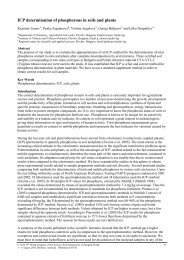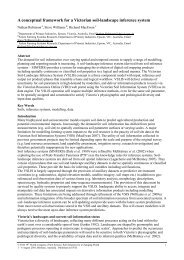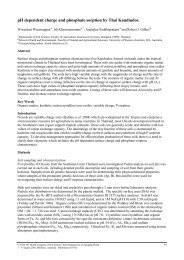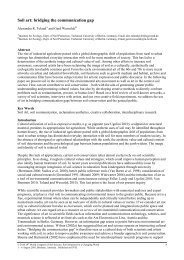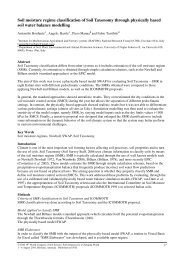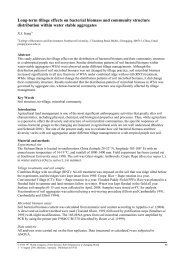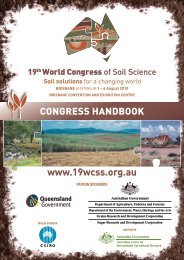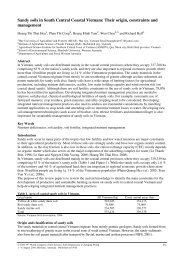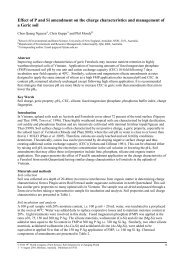Schmidt Sonja
Schmidt Sonja
Schmidt Sonja
Create successful ePaper yourself
Turn your PDF publications into a flip-book with our unique Google optimized e-Paper software.
Visualising and quantifying rhizosphere processes: root-soil contact and water<br />
uptake<br />
<strong>Sonja</strong> <strong>Schmidt</strong> A, B , Peter J. Gregory A , A. Glyn Bengough A , Dmitri V. Grinev B and Iain M. Young C<br />
A Scottish Crop Research Institute, Invergowrie, Dundee, DD2 5DA, Scotland, UK, Email <strong>Sonja</strong>.<strong>Schmidt</strong>@scri.ac.uk<br />
B University of Abertay Dundee, SIMBIOS Centre, Bell Street, Dundee, DD1 1HG, Scotland, UK<br />
C The School of Environmental & Rural Science, University of New England, Armidale, NSW 2351, Australia<br />
Abstract<br />
Root-soil contact is vital for water transport via liquid films. X-ray microtomography potentially makes it<br />
possible to study the root-soil interface non-invasively. This paper presents first attempts to quantify the<br />
contact areas of roots with the three phases of soil systems using X-ray microtomography. Root-particle<br />
contact was investigated producing 3D volumetric images of maize in soil and vermiculite wetted to matric<br />
potentials of -0.03MPa and -1.6MPa. Root-soil contact was calculated to be greater in soil than in<br />
vermiculite. Water volumes in artificial porous media, formed by cellulose acetate beads, were determined<br />
by weighing samples before and after wetting and by image analysis of 3D volumetric images. Image<br />
analysis underestimated the water volume by about 10%. Contact between an artificial root (porous glass<br />
fibre tube) and the solid, liquid and gaseous phases in sand were calculated from 3D volumetric images. The<br />
total sum of contact areas was about 8% greater than the estimated surface area of the root. Results of<br />
repeated image analysis of root-particle contact revealed that changes in threshold values influenced the final<br />
results by up to 12%. Thus, whilst this method has clear potential for investigating the root-soil interface,<br />
there remain several limitations that are being addressed.<br />
Key Words<br />
X-ray microtomography, 3-D visualisation, root-soil interface, root-contact surface area<br />
Introduction<br />
Knowledge of root contact with the soil solution is essential for understanding water and nutrient adsorption<br />
by plants. The contact is influenced by soil and root properties, such as particle size, soil bulk density, root<br />
diameter, soil matric potential and volumetric water content (Tinker 1976; Nye 1994). In water saturated and<br />
heavily compacted soils, problems with gas exchange can occur (Veen et al., 1992). Conversely, incomplete<br />
root-soil contact due to soil structure or root shrinkage can reduce the uptake of water and nutrients (Veen et<br />
al., 1992). A thin section technique was used by Noordwijk et al. (1992) to derive the degree of root-soil<br />
contact in 2D slices. An increase in root-soil contact with increasing bulk density was investigated by<br />
Kooistra et al. (1992). A decrease in water and nitrate uptake per unit root length was associated with smaller<br />
root-soil contact (Veen et al., 1992). Neutron and X-ray computed tomography have been used to provide a<br />
non-invasive methodology to visualise and quantify roots growing in opaque soils (Heeraman et al., 1997;<br />
Lontoc-Roy et al., 2006; Tumlinson et al., 2007; Oswald et al., 2008; Moradi et al., 2009; Carminati et al.,<br />
2009) and establish an approach to examine root-soil contact. Root-soil contact dynamics of lupin plants<br />
under drying and wetting cycles were investigated by Carminati et al. (2009). Changes of water contents<br />
around roots were detected with neutron radiography. A non-uniform water uptake around the root was<br />
observed (Oswald et al., 2008). Quantification of the spatial distribution of solid, liquid and gaseous phases<br />
using X-ray computed tomography was achieved by a cluster analysed segmentation method (Wildenschild<br />
et al., 2002).<br />
In this paper, the use of X-ray microtomography to study the root-soil interface will be discussed and<br />
preliminary data on root-soil contact and water distribution will be presented. Processes for quantifying the<br />
solid, liquid and gaseous phases around the root surface will be reviewed with both artificial and natural<br />
systems.<br />
Methods<br />
X-ray microtomography<br />
3D volumetric images were obtained using a Metris X-Tek HMX CT scanner with a Varian Paxscan 2520V<br />
detector with a 225kV X-ray source and a molybdenum target. 3D volumetric images were reconstructed<br />
with the Metris software CT-Pro v2.0. VGStudioMAX v2.0 was used to analyse the 3D volumetric images.<br />
© 2010 19 th World Congress of Soil Science, Soil Solutions for a Changing World<br />
1 – 6 August 2010, Brisbane, Australia. Published on DVD.<br />
190
Water visualisation<br />
3D volumetric images of water in packed cellulose acetate beads of 1mm and 3mm diameter were obtained.<br />
A 0.75g/100g sodium iodide-spiked solution was used as a wetting fluid to obtain a greater contrast between<br />
the water and solid phases. A high absorption was achieved through the sodium iodide rendering the water<br />
and solid phase separable. Samples were scanned before and after wetting, using a beam with energy of<br />
65kV and a current of 486µA. 2855 projections were acquired. A resolution of 21µm (isotropic voxel size)<br />
was attained. Typically, scans took approximately 150 minutes.<br />
Figure 1. False coloured 3D volumetric images of wetted cellulose acetate beads (3 mm diameter; left), extracted<br />
beads (middle) and extracted water (right).<br />
The volume of water was segmented using 3D volume segmentation tools, which identify and extract voxels<br />
belonging to calculated ranges of greyscale values (representing water phase in the sample). As a control the<br />
sample was weighed before and after wetting.<br />
Contact areas of the root with the water, air and solid phases of the growth medium<br />
Root-particle contact was estimated for 3D volumetric images of maize seeds growing in soil and vermiculite<br />
at matric potentials of -0.03MPa and -1.6MPa. The pre-germinated seeds were grown for 2 days at 20ºC in<br />
darkness. The samples were scanned using a beam with energy of 145kV and a current of 140µA. 2987<br />
projections were acquired. Typically, scans took 180 minutes. Three replications of each treatment were<br />
analysed twice by the same operator. The sample size was 3 cm in diameter and 10 cm high. To differentiate<br />
the contact areas of the root with air, water and solid phase, an artificial root (porous glass fibre tube of 1.5<br />
mm in diameter) in sand was scanned. The sand was wetted with 0.75% sodium iodide solution (see above)<br />
and drained by applying suction to the artificial root. The sample was scanned with energy of 85kV and a<br />
current of 296µA with 2855 projections acquired. The sample was 1.5 cm in diameter and 10 cm high.<br />
Resolutions of 35µm for the samples in soil and vermiculite and 18µm for the sample in sand were attained.<br />
Figure 2. Region of interest with artificial root in sand (partly drained; left), polygonal mesh of root volume for<br />
calculating the root surface area (middle) and polygonal mesh of root sand contact surface area (right).<br />
Image analysis was performed to determine the contact areas of liquid, air and solid phases with the root. For<br />
calculating the root surface and contact surface area, the root volume was segmented. Advanced calibration<br />
and 3D volume segmentation tools, which identify and extract voxels belonging to calculated ranges of<br />
greyscale values (representing root, water, air and solid particle) were used to segment the root volume. The<br />
surface area of the root was determined for the extracted root volume. The contact surface area of root with<br />
the three different phases of the sample were investigated, by subtracting voxels representing each phase<br />
which were adjacent to voxels of the root volume from the volumetric region of the root.<br />
Results<br />
Water visualisation<br />
In Figure 3 the volumes of water added to the packed cellulose acetate beads (1 mm and 3 mm diam.) and<br />
calculated from 3D images are shown. Image analysis underestimated the volume of water by 11% for 1 mm<br />
beads and 8% for 3 mm beads.<br />
© 2010 19 th World Congress of Soil Science, Soil Solutions for a Changing World<br />
1 – 6 August 2010, Brisbane, Australia. Published on DVD.<br />
191
3000<br />
2500<br />
mass water<br />
image analysis<br />
water [mm 3 ]<br />
2000<br />
1500<br />
1000<br />
500<br />
0<br />
1mm<br />
Figure 3. Water volume determined by weighing samples before and after adding water to cellulose<br />
acetate beads of 1mm and 3mm size and by image analysis with VGStudioMAX v2.0.<br />
Root-soil interface contact areas<br />
The results for root-particle contact of maize in soil and vermiculite at -0.03MPa and -1.6MPa are shown in<br />
Figure 4. The determination of root-particle contact in VGStudioMAX v2.0 was done twice. The second<br />
time (VGStudio MAX (2)) the root-soil contact for all samples except maize in vermiculite at -1.6MPa was<br />
greater than that determined in the first attempt (VGStudio MAX (1)). The results for both investigations<br />
showed greater root-particle contact in soil than in vermiculite.<br />
3mm<br />
relative root-particle contact area [%]<br />
80<br />
60<br />
40<br />
20<br />
0<br />
soil -0.03MPa<br />
soil -1.6MPa<br />
vermiculite -0.03MPa<br />
VGStudio MAX (1)<br />
VGStudio MAX (2)<br />
vermiculite -1.6MPa<br />
Figure 4. Root-particle contact of maize in soil<br />
and vermiculite at matric potentials of -<br />
0.03MPa and -1.6MPa analysed in VG Studio<br />
MAX v.2.0 at two time points, average<br />
differences between the 1 st and 2 nd attempt are<br />
ca. 6-11% (left).<br />
surface and contact area [mm 3 ]<br />
180<br />
160<br />
140<br />
120<br />
100<br />
80<br />
60<br />
40<br />
20<br />
0<br />
154<br />
51<br />
root surface area<br />
root-water contact area<br />
root-particle contact area<br />
root-air contact area<br />
Figure 5. Surface area of artificial root (black) and<br />
contact surface areas of artificial root in contact with<br />
water, solid and air (grey; right).<br />
74<br />
37<br />
The contact surface areas of an artificial root with air, water and sand particle are shown in Figure 5. The<br />
total root surface area of the root volume was 154 mm 2 . The total contact surface area was 162 mm 2<br />
according to the image analysis in VGStudioMAX, where the water phase contributed the greatest part at<br />
74 mm 2 and the solid phase the smallest part at 37 mm 2 .<br />
Discussion and Future Work<br />
These studies investigated the use of X-ray microtomography for quantifying contact areas of roots in a three<br />
phase system. The water, air and solid phases could be clearly distinguished. It was possible to segment<br />
voxels containing water in a bead system using a contrast enhancer (NaI). The concentration of the contrast<br />
enhancer was kept as small as practicable, resulting in relatively small contrast between solid and liquid<br />
phase, making discrimination between water and solid voxels difficult. A small proportion of voxels<br />
containing water might have been counted as voxels representing beads. However, the water volume was<br />
underestimated by 8-11%. To better quantify this source of uncertainty, we intend comparing the volume of<br />
the beads in dry samples (two phase system, big contrast) with the volume estimated with water present to<br />
help specify the effects of decreasing contrast. A similar approach was used by Culligan et al. (2004) where<br />
© 2010 19 th World Congress of Soil Science, Soil Solutions for a Changing World<br />
1 – 6 August 2010, Brisbane, Australia. Published on DVD.<br />
192
partially saturated images were registered with the dry image to create tertiary volume in which the solid,<br />
liquid, and air phase were quantified.<br />
Image analysis of root-particle contact of maize grown in soil and vermiculite showed a greater root-soil<br />
contact than in vermiculite. This was expected because of the greater particle sizes of vermiculite and smaller<br />
bulk density (Kooistra et al., 1992). Yet, repeating the image analysis on the same samples showed a<br />
variation of 6 to 12% in the relative root-particle contact. This was probably because the contrast between<br />
root and solid particles was relatively poor and partial volume effects made it difficult to specify the borders<br />
between root and solid phase. In the procedure, several parameters are changed manually to extract the<br />
different phases and define the root-particle contact areas. A sensitivity analysis of those parameters on a<br />
model system of known dimensions is underway to help improve the methodology. Extracting the three<br />
phases and calculating the contact areas with an artificial root in sand was possible but a greater cumulative<br />
contact surface area resulted – this is probably because voxels were classified non-uniquely, with certain<br />
voxels being double-counted as both root-solid and root-water interfaces. This may also have been associated<br />
with partial volume effects making the segmentation of the phases more difficult and adding to this double<br />
counting. We are currently modifying the procedure to reduce this source of error.<br />
In conclusion, X-ray microtomography and 3D image analysis algorithms are useful tools to study the rootsoil<br />
interface and determine contact areas, but require both careful optimisation of image quality and the<br />
development of rigorous image analysis protocols that minimise elements of subjectivity.<br />
Acknowledgements<br />
PhD Studentship for <strong>Sonja</strong> <strong>Schmidt</strong> was funded by SCRI and University of Abertay Dundee. SCRI receives<br />
funding from the Scottish Government Rural and Environmental Research and Analysis Directorate.<br />
References<br />
Carminati A, Vetterlein D, Weller U, Vogel HJ, Oswald SE (2009) When roots lose contact. Vadose Zone<br />
Journal 8, 805-809.<br />
Culligan KA, Wildenschild D, Christensen BSB, Gray WG, Rivers ML, Tompson FB (2004) Interfacial area<br />
measurements for unsaturated flow through a porous medium. Water Resources Research 40, W12413.<br />
Heeraman DA, Hopmans JW, Clausnitzer V (1997) Three dimensional imaging of plant roots in situ with X-<br />
ray computed tomography. Plant and Soil 189, 167-179.<br />
Kooistra MJ, Schoonderbeek D, Boone FR, Veen BW, Van Noordwijk M (1992) Root-soil contact of maize, as<br />
measured by a thin-section technique 2. Effects of soil compaction. Plant and Soil 139, 119-129.<br />
Lontoc-Roy M, Dutilleul P, Prasher SO, Han L, Brouillet T, Smith DL (2006) Advances in the acquisition and<br />
analysis of CT scan data to isolate a crop root system from the soil medium and quantify root system<br />
complexity in 3-D space. Geoderma 137, 231-241.<br />
Moradi AB, Conesa HM, Robinson B, Lehmann E, Kuehne G, Kaestner A, Oswald S, Schulin R (2009)<br />
Neutron radiography as a tool for revealing root development in soil: capabilities and limitations. Plant and<br />
Soil 318, 243-255.<br />
Noordwijk M, Kooistra MJ, Boone FR, Veen BW, Schoonderbeek D (1992) Root-soil contact of maize, as<br />
measured by a thin-section technique. I. Validity of the method. Plant and Soil 139, 109-118.<br />
Nye PH (1994) The effect of root shrinkage on soil-water inflow. Philosophical Transactions of the Royal<br />
Society of London Series B-Biological Sciences 345, 395-402.<br />
Oswald SE, Menon M, Carminati A, Vontobel P, Lehmann E, Schulin R (2008) Quantitative imaging of<br />
infiltration, root growth, and root water uptake via neutron radiography. Vadose Zone Journal 7, 1035-1047.<br />
Tinker PB (1976) Roots and water - transport of water to plant roots in soil. Philosophical Transactions of the<br />
Royal Society of London Series B-Biological Sciences 273, 445-461.<br />
Tumlinson LG, Liu H, Silk WK, Hopmans JW (2008) Thermal neutron computed tomography of soil water<br />
and plant roots. Soil Science Society of America Journal 72, 1234-1242.<br />
Veen BW, Van Noordwijk M, De Willigen P, Boone FR, Kooistra MJ (1992) Root-soil contact of maize, as<br />
measured by a thin-section technique 3. Effects on shoot growth, nitrate and water-uptake efficiency. Plant<br />
and Soil 139, 131-138<br />
Wildenschild D, Hopmans JW, Vaz CMP, Rivers ML, Rikard D, Christensen BSB (2002) Using X-ray<br />
computed tomography in hydrology: Systems, resolutions, and limitations. Journal of Hydrology 267, 285-<br />
297.<br />
© 2010 19 th World Congress of Soil Science, Soil Solutions for a Changing World<br />
1 – 6 August 2010, Brisbane, Australia. Published on DVD.<br />
193



